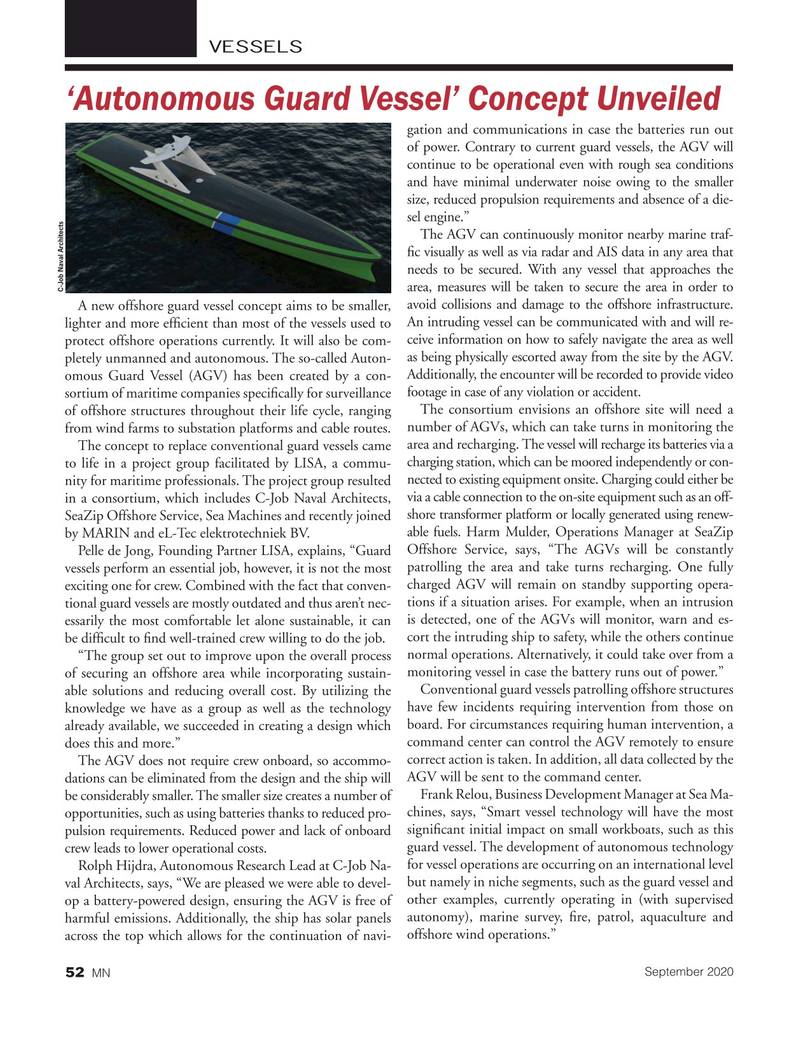
Page 52: of Marine News Magazine (September 2020)
Offshore Annual
Read this page in Pdf, Flash or Html5 edition of September 2020 Marine News Magazine
VESSELS ‘Autonomous Guard Vessel’ Concept Unveiled gation and communications in case the batteries run out of power. Contrary to current guard vessels, the AGV will continue to be operational even with rough sea conditions and have minimal underwater noise owing to the smaller size, reduced propulsion requirements and absence of a die- sel engine.”
The AGV can continuously monitor nearby marine traf- ? c visually as well as via radar and AIS data in any area that needs to be secured. With any vessel that approaches the area, measures will be taken to secure the area in order to
C-Job Naval Architects
A new offshore guard vessel concept aims to be smaller, avoid collisions and damage to the offshore infrastructure. lighter and more ef? cient than most of the vessels used to An intruding vessel can be communicated with and will re- protect offshore operations currently. It will also be com- ceive information on how to safely navigate the area as well pletely unmanned and autonomous. The so-called Auton- as being physically escorted away from the site by the AGV. omous Guard Vessel (AGV) has been created by a con- Additionally, the encounter will be recorded to provide video sortium of maritime companies speci? cally for surveillance footage in case of any violation or accident.
of offshore structures throughout their life cycle, ranging The consortium envisions an offshore site will need a from wind farms to substation platforms and cable routes. number of AGVs, which can take turns in monitoring the
The concept to replace conventional guard vessels came area and recharging. The vessel will recharge its batteries via a to life in a project group facilitated by LISA, a commu- charging station, which can be moored independently or con- nity for maritime professionals. The project group resulted nected to existing equipment onsite. Charging could either be in a consortium, which includes C-Job Naval Architects, via a cable connection to the on-site equipment such as an off-
SeaZip Offshore Service, Sea Machines and recently joined shore transformer platform or locally generated using renew- by MARIN and eL-Tec elektrotechniek BV. able fuels. Harm Mulder, Operations Manager at SeaZip
Pelle de Jong, Founding Partner LISA, explains, “Guard Offshore Service, says, “The AGVs will be constantly vessels perform an essential job, however, it is not the most patrolling the area and take turns recharging. One fully exciting one for crew. Combined with the fact that conven- charged AGV will remain on standby supporting opera- tional guard vessels are mostly outdated and thus aren’t nec- tions if a situation arises. For example, when an intrusion essarily the most comfortable let alone sustainable, it can is detected, one of the AGVs will monitor, warn and es- be dif? cult to ? nd well-trained crew willing to do the job. cort the intruding ship to safety, while the others continue “The group set out to improve upon the overall process normal operations. Alternatively, it could take over from a of securing an offshore area while incorporating sustain- monitoring vessel in case the battery runs out of power.” able solutions and reducing overall cost. By utilizing the Conventional guard vessels patrolling offshore structures knowledge we have as a group as well as the technology have few incidents requiring intervention from those on already available, we succeeded in creating a design which board. For circumstances requiring human intervention, a does this and more.” command center can control the AGV remotely to ensure
The AGV does not require crew onboard, so accommo- correct action is taken. In addition, all data collected by the dations can be eliminated from the design and the ship will AGV will be sent to the command center.
be considerably smaller. The smaller size creates a number of Frank Relou, Business Development Manager at Sea Ma- opportunities, such as using batteries thanks to reduced pro- chines, says, “Smart vessel technology will have the most pulsion requirements. Reduced power and lack of onboard signi? cant initial impact on small workboats, such as this crew leads to lower operational costs. guard vessel. The development of autonomous technology
Rolph Hijdra, Autonomous Research Lead at C-Job Na- for vessel operations are occurring on an international level val Architects, says, “We are pleased we were able to devel- but namely in niche segments, such as the guard vessel and op a battery-powered design, ensuring the AGV is free of other examples, currently operating in (with supervised harmful emissions. Additionally, the ship has solar panels autonomy), marine survey, ? re, patrol, aquaculture and across the top which allows for the continuation of navi- offshore wind operations.”
September 2020
MN 52

 51
51

 53
53
